
Weight Loss Calculator
Calorie Needed To Lose Weight:
_____ Calories/day
| Weight Loss Parameters | Value |
|---|---|
| Current Weight | |
| Goal Weight | |
| Goal Time (In days) | |
| To Maintain Weight (calorie/day) | |
| Calorie Deficit (calorie/day) |
Looking for an online calorie deficit weight loss calculator that accurately estimates the time (in weeks or months) needed to achieve a specific weight loss goal? Look no further.
Our deficit calorie calculator can determine the time needed for both healthy and fast weight loss and the required daily or weekly calorie intake. It is suitable for both men and women.
To use our weight loss calculator, please enter your age, height, current weight, desired weight, and target timeframe for achieving your goal.
The calculator will provide precise results and even generate a weight loss chart to help you better understand how calorie intake affects weight loss.
Note: It is not advisable to limit the daily caloric intake to less than 1200-1600 for men and 1000-1200 for women.
Table Of Contents
- What is weight loss?
- What is a Calories Deficit Weight Loss Calculator?
- How to Use a Calories Deficit Weight Loss Calculator
- Benefits of Using a Weight Loss Calculator
- How To Lose Weight Fast
- How To Calculate Calories Require To Loss Weight
- Weight Loss Calculator by Date
- How Many Calories Do You Need To Lose Weight?
- Calculate Your Daily Calories Requirement
- Zigzag Calorie Cycling to Lose Weight
- How To Calculate Zigzag Calorie Cycling
What is Weight Loss?
Weight loss is the process of reducing one’s body weight, typically by burning more calories than one consumes, through a combination of diet and exercise.
Various methods can be used to achieve a healthy weight, such as:
- Eating a healthy diet
- Doing physical activity,
- Living an active lifestyle
- Get enough sleep and manage stress.
- Drink plenty of water.
Many studies have shown that people who are overweight or obese are more likely to develop health problems, such as heart disease, diabetes, and joint pain.
However, it’s important to note that weight loss should always be done healthily and sustainably.
Reducing calorie intake to achieve a healthy weight is a desirable goal. However, striving to lose weight to conform to social norms when one is already at a healthy weight is not advisable.
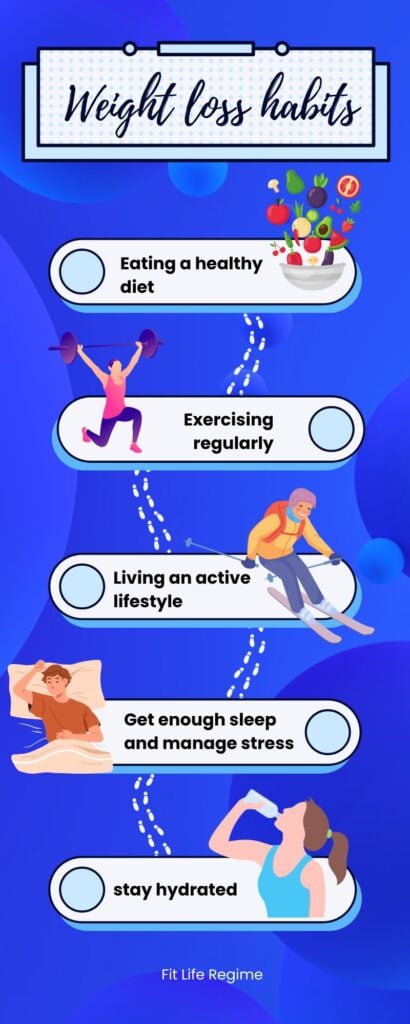
Type of Weight Loss
There are two main types of weight loss: intentional and unintentional.
- Intentional weight loss is a deliberate effort to lose weight, usually for personal reasons, such as to improve one’s appearance. This weight loss type is achieved by following a specific diet and exercise regimen.
- On the other hand, unintentional weight loss occurs when a person loses weight without intending to do so. This can happen over a period of 6–12 months due to underlying health issues.
To determine the right number of calories needed to achieve your target weight, use our Weight Loss Calculator.
To Know Your Body Fat %: Use Our Body Fat % Calculator
What Is A Calorie Deficit Weight Loss Calculator?
A weight loss calculator is a digital tool designed to help people estimate various metrics associated with weight loss.
These calculators look at things like age, gender, height, current weight, and how much exercise you do to help you lose weight. They can advise on how many calories to eat, how much exercise to do, and how long to do it.
Basic Features of Weight Loss Calculators
- Caloric Intake Estimation: Most weight loss calculators estimate how many calories you should consume daily to reach a specific weight loss goal within a certain period.
- Basal Metabolic Rate (BMR): Many calculators also estimate your BMR, which is the number of calories your body requires to maintain basic physiological functions.
- Physical Activity Level (PAL): Your activity level is considered when adjusting your recommended caloric intake, depending on whether you are sedentary, lightly active, or highly active.
- Timeframe for Weight Loss: estimate how long it will take for you to reach your weight loss goal based on the information you provide and the caloric deficit you are willing to maintain.
- Exercise Recommendations: offer exercise suggestions to help you burn extra calories. This can be helpful for people who like to eat more calories and balance it out with physical activity.
How to Use a Calories Deficit Weight Loss Calculator
To use a calorie deficit weight loss calculator, follow these steps:
- Input your current weight and goal weight accurately. Weigh yourself under consistent conditions.
- Be honest about your activity level. Sedentary, moderately active, active, or very active. This affects your calorie needs.
- Use your actual height, age, and gender. The calculator uses these to estimate your basal metabolic rate.
- Start with a modest calorie deficit of 500 calories per day for 1 lb per week weight loss. Avoid extreme deficits.
- If you find that your calorie target is too aggressive or is not leading to expected weight loss, you should adjust it.
- Re-calculate your calories every 10 lbs as you lose weight to account for your new weight.
- Focus on nutritious whole foods within your target calories and macronutrient goals.
- Use a food-tracking app consistently to ensure you stick to your calorie target.
- Weigh yourself weekly under the same conditions and adjust your calories if needed.
- Don’t rely solely on the calculator. Listen to your body’s hunger and fullness signals.
- Be patient! Steady weight loss of 1-2 lbs per week is healthier and more sustainable in the long term.

Calculate Weight Loss Calorie Requirement Per Week
Here is how you can calculate your weight loss calories:
1. Determine Your BMR
Use an online BMR calculator or the Mifflin-St Jeor Equation to estimate your BMR based on your age, gender, weight, and height.
- For men: BMR = (10 x weight in kg) + (6.25 x height in cm) – (5 x age in years) + 5
- For women: BMR = (10 x weight in kg) + (6.25 x height in cm) – (5 x age in years) – 161
2. Estimate Your Activity Level
Based on your daily routine and exercise habits, you should estimate how many calories you burn through physical activity.
There are several ways to do this, but a common method is to use an activity multiplier:
Activity Level
- Sedentary (little or no exercise): BMR x 1.2
- Lightly active (1-3 days of exercise per week): BMR x 1.375
- Moderately active (3-5 days of exercise per week): BMR x 1.55
- Very active (6-7 days of exercise per week): BMR x 1.725
- Extra active (very intense exercise or physical job): BMR x 1.9
3. Calculate Your TDEE
- TDEE = BMR + Activity Level
4. Calculator Calories For Weight Loss
Once you have calculated your TDEE, you can adjust your calorie intake to achieve your desired weight loss or gain.
- To lose weight, you must create a calorie deficit by consuming fewer calories than your TDEE. A deficit of 500–1000 calories per day is recommended for safe and sustainable weight loss.
- Keep track of your calorie intake and make gradual changes to ensure you are on track towards your goal.
- 1 kg of body fat contains approximately 7700 calories.
- 1 pound of body fat contains approximately 3500 calories.
To Lose Weight, 0.25 Kg/Week
- = (0.25 kg x 7700 calories/kg ÷ 7 days/week).
- You need a 275-calorie deficit per day.
- If your TDEE is 2000 calories per day, you should consume 1725 calories per day (2000 – 275) to lose 0.25 kg/week.
To Lose Weight, 0.5 Kg/Week
- = (0.5 x 7700 ÷ 7).
- You need a 550-calorie deficit per day.
- If your TDEE is 2000 calories per day, you should consume 1450 calories per day (2000 – 550) to lose 0.5 kg/week.
To Lose Weight, 1 Kg/Week
- = (1 x 7700 ÷ 7).
- You need an 1100-calorie deficit per day.
- If your TDEE is 2000 calories per day, you should consume 900 calories daily (2000 – 1100) to lose 1 kg/week.
5. Calculate Zig Zag Diet Calories
To calculate Zigzag calories, you must determine your weekly calorie target and alternate between high and low-calorie days to meet that target.
- Determine your weekly calorie target based on your weight loss.
- Daily Calorie Target = Weekly Calorie Target / 7
- Alternate between low and high-calorie days to create a calorie deficit for weight loss.
- On low-calorie days, consume 300–500 calories less than your daily target,
- On high-calorie days, consume 100–300 calories more than your daily target to prevent weight loss plateaus.
6. Track Your Weekly Weight Loss Calories
Choose a way to track your calories and weight loss progress. Several tools can help:
- Smartphone apps: Many user-friendly apps track your food intake, exercise, and weight loss journey.
- Estimating calories: While calorie counting can be tedious, learning to estimate the calorie content of common meals can help you make informed food choices without constant tracking.
- Manual tracking: An Excel spreadsheet or a simple journal are perfectly good options if you prefer a traditional approach.
7. Track Your Progress
Take time to track your progress and adjust your plan accordingly. You should consider weight loss and muscle gain or fat loss when determining your health and fitness.
Furthermore, measurements should be taken over longer periods of time, such as a week (rather than daily), as significant variations in weight can occur based on water intake or time of day.
For consistent measurements, weigh yourself every day at the same time, like right after you wake up and before breakfast.
Keynote:
Remembering that a proper diet and regular exercise are widely recognized as the most effective ways to achieve weight loss is essential.
Decreasing your daily calorie intake by over 1,000 calories is not recommended, as losing more than 2 pounds (0.91 kg) per week can be harmful. It may result in a decreased metabolism in the future due to the loss of muscle mass.
Losing weight too quickly can lead to dehydration, which is also unhealthy. In addition, maintaining a healthy diet is crucial when exercising and dieting to support the body’s metabolic processes and replenish itself.
Severely restrictive diets can have serious negative effects by depriving the body of necessary nutrients. They are unsustainable, with regained weight typically resulting in fat. This leaves the individual in a worse state than when they started.
Thus, monitoring calorie and fiber intake is important while ensuring the body receives all other necessary nutrients.
Please consult a doctor when losing 1 kg or more per week, since it requires that you consume less than the minimum recommendation of 1,200 calories a day.
Calculate Weight Loss Calories Per Day
Let’s say a 40-year-old female weighs 70 kilograms (154 pounds) and is 170 centimeters (5 feet 7 inches) tall.
To calculate her estimated BMR using the Mifflin-St. Jeor equation, we need to use the following formula:
- BMR = (10 x weight in kg) + (6.25 x height in cm) – (5 x age in years) – 161
Substituting the values into the equation to get BMR:
- = (10 x 70) + (6.25 x 170) – (5 x 40) – 161
- = 700 + 1062.5 – 200 – 161
- = 1,401.5 calories per day
TDEE for Lightly active (1-3 days of exercise per week): BMR x 1.375
- TDEE =1401.5 x 1.375
- TDEE = 1927.06
TDEE is the total calories you could eat every day if you wanted to maintain your weight.
If you want to lose weight, you must consume fewer calories daily, increase your activity level, or do both.
To Lose Weight, 0.25 Kg/Week
- = (0.25 kg x 7700 calories/kg ÷ 7 days/week).
- You need a 275-calorie deficit per day.
- Your TDEE is 1927 calories per day; you should consume 1652 calories per day (1927– 275) to lose 0.25 kg/week.
Weight Loss Calculator By Goal Date
A weight loss calculator by date is a tool that estimates how much weight you can lose within a specific time frame based on the number of calories you consume and the amount of physical activity you engage in.
To use a weight loss calculator by date, you typically input information such as your current weight, height, age, and activity level. You may also need to input your gender, as well as your goal weight and the date by which you want to achieve it.
Once you have entered this information, the calculator will estimate the number of calories you need to consume each day to lose weight at a safe and healthy rate. This rate is typically 1–2 pounds per week.
It is a useful tool for setting realistic weight loss goals and tracking progress, but it should be used in conjunction with a healthy diet and regular exercise regimen.
Weight Loss Percentage Calculator
Tracking your weight loss progress can be motivating. To calculate your weight loss percentage, your current weight is subtracted from the weight you were at when you first began your efforts to lose weight.
This figure is then divided by your starting weight, and the resulting number is multiplied by 100. This will give you your weight loss percentage. This formula can be presented as follows:
- Weight Loss Percentage (%) = [ (Starting Weight − Current Weight) / Starting Weight ] × 100
- Percentage of weight lost = (Total pounds lost ÷ Starting weight) x 100
For example, if you weighed 200 pounds originally and have lost 10 pounds, your calculations would be:
- (10 pounds lost ÷ 200 original pounds) x 100 = 5%
- So you have lost 5% of your starting body weight.
Stay motivated and continue reaching your goals through smart goal-setting and dedication. You can do it!
Weight Loss Calculator by Calories
Determining the appropriate daily caloric intake is crucial for losing weight. However, there is no one-size-fits-all answer to the question of how many calories a person needs to maintain a healthy weight.
Several factors include age, weight, height, sex, physical activity levels, and overall health status.
For instance, A teenage athlete who plays basketball for several hours each day will require more calories than a sedentary office worker of the same age and gender.
The athlete’s body will need more energy to sustain the physical demands of their sport and maintain optimal health, while the office worker’s body will require fewer calories to maintain basic bodily functions.
The 2015-2020 Dietary Guidelines for Americans state that the daily calorie requirements for:
- Women typically range from 1,600 to 2,400,
- Men may need anywhere from 2,000 to 3,000 calories per day.
However, these figures can vary based on various factors such as age, body size, height, overall health, lifestyle, and activity level.
The body requires a minimal number of calories to survive, but eating too few calories can lead to poor bodily function since the body will only use calories for essential functions necessary for survival, disregarding those vital for general health and well-being.
As per Harvard Health Publications, women should consume at least 1,200 calories a day, and men should consume at least 1,500 calories a day unless advised by a medical professional.
For example, to lose 1 to 2 pounds a week — a rate experts consider safe — your food consumption should be 500 to 1,000 calories less than your total weight-maintenance calories.
Calculate Your Daily Calories Requirement
While adhering to a rigorous weight loss regimen can help you achieve your desired weight, many people struggle to understand their daily caloric needs and plan a diet accordingly. That’s where our Weight Loss Calculator comes in handy.
This useful tool is ideal for anyone looking to shed some pounds. It calculates your daily and weekly calorie requirements and estimates how long it will take for you to achieve your weight loss goals healthily and safely.
Zigzag Calorie Cycling to Lose Weight
Zigzag calorie cycling is an approach to weight loss that aims to overcome the body’s tendency to adapt to a lower calorie intake. Counting and restricting calories can be effective, but over time, the body may adapt to the lower-calorie environment, resulting in a plateau in weight loss that may be difficult to overcome. Zigzag calorie cycling helps to prevent this adaptation by alternating the number of calories consumed on a given day.
With zigzag calorie cycling, a person alternates between high and low-calorie days to meet the same weekly calorie target. For example, a person with a weekly calorie target of 14,000 could consume 2,300 calories three days a week and 1,775 calories the other four days, or they could consume 2,000 calories each day.
Zigzag calorie cycling also provides flexibility in the diet, allowing a person to plan for occasions where they may consume more calories, such as family gatherings or work events. By consuming fewer calories on other days, a person can make up for these excess calories without feeling guilty.
There is no concrete rule on how to vary calorie intake with zigzag calorie cycling, as it largely depends on personal discretion and activity level.
Generally, the high and low-calorie days should vary by approximately 200–300 calories, with the high-calorie day being the number of calories needed to maintain current weight. The calorie difference should be larger for those with a higher activity level.
The calculator provides two zigzag diet schedules, one with two high-calorie days and five low-calorie days, and one that gradually increases and reduces calories. However, finding an approach that works for you and fits your lifestyle is important.
Calorie counting and zigzag calorie cycling are just two methods among many for achieving weight loss, and there are many possible approaches within these methods. The best result will come from finding an approach that you can stick too consistently.
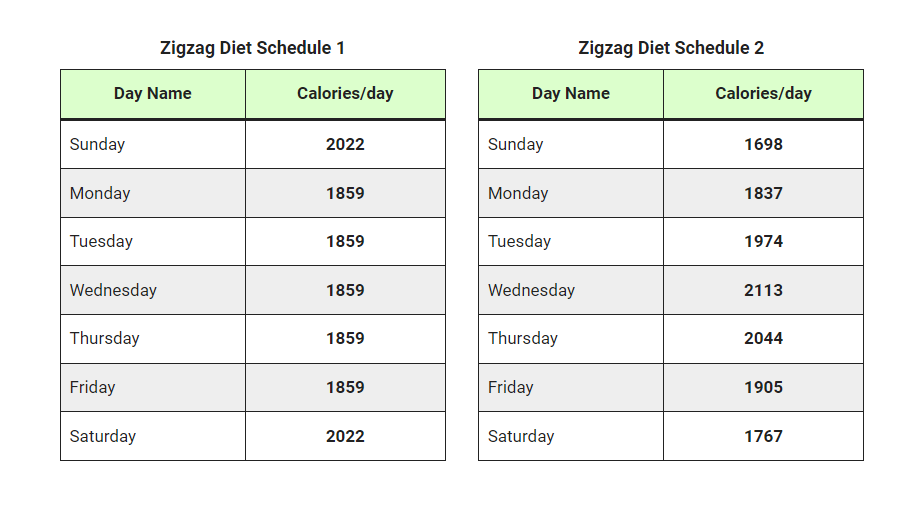
How To Calculate Zigzag Calorie Cycling
- Daily Calorie Target (Weight Loss) = Weekly Calorie Target / 7
- Plan low-calorie days when you consume 300–500 calories less than your daily calorie target.
- Low-Calorie Day Target = Daily Calorie Target – (300-500) calories.
- Plan high-calorie days when you consume 100–300 calories more than your daily calorie target. This helps to prevent your metabolism from slowing down and can help to prevent weight loss plateaus.
- High Calorie Day Target = Daily Calorie Target + (100-300) Calories
- Create a schedule for your low and high-calorie days, and stick to it consistently.
- Example: Monday – Low Calorie Day
- Tuesday – High Calorie Day
- Wednesday – Low-Calorie Day, and so on.
- Monitor your progress by regularly weighing yourself and taking body measurements. Adjust your calorie intake as needed based on your progress.
- If your progress is slower than expected, you can reduce your calorie intake on high-calorie days or increase your calorie deficit on low-calorie days.
- If your progress is faster than expected, you may need to increase your calorie intake on high-calorie days or decrease your calorie deficit on low-calorie days.
- Remember to maintain a balanced and nutritious diet, regardless of the calorie intake on a given day. It’s important to consume a variety of nutrient-dense foods to support your overall health and well-being.
Benefits of Using a Weight Loss Calculator
Using a weight loss calculator can offer a range of benefits to help you on your weight loss journey. Here are some of the key advantages:
1. Personalized Information
Weight loss calculators can provide personalized recommendations based on your age, gender, height, weight, and activity level. This allows for a more targeted approach than generic diet and exercise plans.
2. Goal Setting
Having a number for your caloric needs and potential weight loss helps you set achievable and realistic goals. This, in turn, can increase your chances of sticking to your weight loss plan.
3. Increased Awareness
Understanding the numbers behind your weight loss journey can make you more conscious of your dietary choices and activity levels, thereby fostering healthier habits.
4. Time-Saving
A weight loss calculator can provide instant estimates that can serve as a starting point for your weight loss plan instead of spending hours researching or consulting with experts.
5. Enhanced Motivation
Seeing potential weight loss numbers is a good way to get motivated. Having a sense of direction or needing adjustments can keep you focused and committed.
Regularly updating your information in a weight loss calculator can be a form of self-monitoring. Consequently, you’ll be more accountable and likely to stick to your weight reduction plan.
To Stay Motivated: 150+ Gym Workout Motivational Quotes To Stay Fit
6. Informed Decision-Making
The insights gained from using a weight loss calculator can help you make informed choices about food, exercise, and lifestyle changes. This leads to a more effective and sustainable weight loss strategy.
7. Versatility
Many weight loss calculators have extra options, like counting calories from exercise or determining what nutrients are in food. Like Our calorie Deficit weight loss calculator.
This makes them useful tools that can be changed in many different ways.
8. Cost-Effectiveness
Weight loss calculators are available for free or for a nominal fee, making them an affordable tool that can provide invaluable insights.
How To Lose Weight Fast
It’s important to note that rapid weight loss is not always healthy or sustainable in the long term.
However, here are some general tips for losing weight in a relatively quick and healthy manner:
1. Reduce Sugar And Processed Foods
These foods are often high in calories, added sugars, and unhealthy fats, which can contribute to weight gain and other health problems.
The most effective approach to reducing arm fat is changing your diet. Start by cutting out sugary and processed foods, as they are high in calories and can be difficult to burn off.
Additionally, processed foods often lack essential nutrients, making it difficult to meet your daily nutritional needs.
Opt for leaner protein sources such as fish, lean meats or legumes instead of fatty cuts of meat.
These changes will help you eat fewer calories overall while still getting the vitamins and minerals you need to stay healthy.

Tips To Reduce Sugar And Processed Foods In Your Diet
- Read food labels and pay attention to the sugar content
- Use fresh ingredients to cook more meals at home.
- Try to limit your intake of fast food and take-out
- Try to replace processed snacks with fruits, vegetables, nuts, or seeds
- Avoid added sugars in your drinks, such as soda and juice
Remember, it’s important to make changes that are sustainable for you and your lifestyle. Make small changes and gradually reduce the amount of processed foods and added sugars you eat.
2. Eat More Protein
Increasing your daily protein intake is an effective way to aid fat loss and muscle building. Protein contains high-quality nutrients that will help you burn more calories throughout the day.
High-protein foods also help build muscle, which will aid in burning extra calories.
Protein helps keep you full and satisfied for longer periods, which helps reduce overall calorie intake.
Eating moderate lean protein at each meal and snack can help you reach your weight loss goals quickly and effectively.
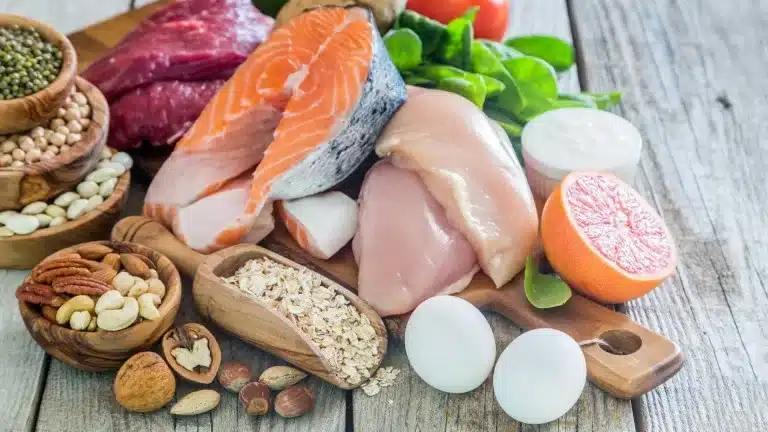
High-Protein Foods
- Chicken, turkey, and fish
- Tofu, tempeh, and other plant-based protein sources
- Eggs, dairy products, and Greek yogurt
- Legumes such as lentils, chickpeas, and beans
- Nuts and seeds
How To Increase Protein Intake
- Start your day with a protein-packed breakfast, such as eggs or Greek yogurt.
- Incorporate protein-rich foods into your snacks, such as almonds or hard-boiled eggs.
- Ensure to include protein with every meal, such as grilled chicken with a salad or a lentil stew.
- Try using protein powders as a supplement, such as whey or pea protein
Remember to vary your protein sources and try to include a balance of animal-based and plant-based options.
Eating more protein can help you feel full, satisfied, and energized.
3. Get Enough Sleep
Lack of sleep disrupts the balance of hormones involved in appetite regulation, leading to increased hunger and cravings.
When you’re sleep-deprived, the hormone ghrelin, which stimulates hunger, tends to increase, while leptin, which signals fullness, decreases. This imbalance can make it harder to stick to a healthy eating plan.
Lack of sleep can also lead to fatigue, making it harder to stick to an exercise routine.

Tips For Improving Sleep Habits
- Stick to a consistent sleep schedule, aim for 7–9 hours of sleep per night
- Create a sleep-conducive environment in your bedroom. Keep it dark, cool, and quiet.
- Avoid screens for at least an hour before you go to sleep.
- Practice relaxation techniques such as yoga, meditation, or deep breathing
- Avoid caffeine, nicotine, and alcohol before bedtime.
Ensure you sleep enough to control your appetite and have more energy to stick to your exercise routine.
With a good night’s sleep, you’ll be more likely to stick to your weight loss goals and feel refreshed and energized.
4. Incorporate More Fiber
Fiber moves slowly through the digestive tract and that helps you feel fuller for longer, which can help you lose weight faster.
Fiber is a type of carbohydrate that is not digestible and helps keep you full and satisfied for longer periods. It helps to reduce overall calorie intake.
Additionally, fiber is essential for maintaining a healthy digestive system. It also helps to lower cholesterol and blood sugar levels.
The recommended daily intake of fiber for adults is 25 grams for women and 38 grams for men.
Here is a USDA list of foods that are good sources of fiber:
| Food | Fiber/100 g (approx.) |
|---|---|
| Oats | 10.1 g |
| Chickpeas | 7.6 g |
| Bananas | 2.6 g |
| Brussels Sprouts | 3.8 g |
| Beets | 2.8 g |
| Apples | 2.4 g |
| Quinoa | 2.8 g |
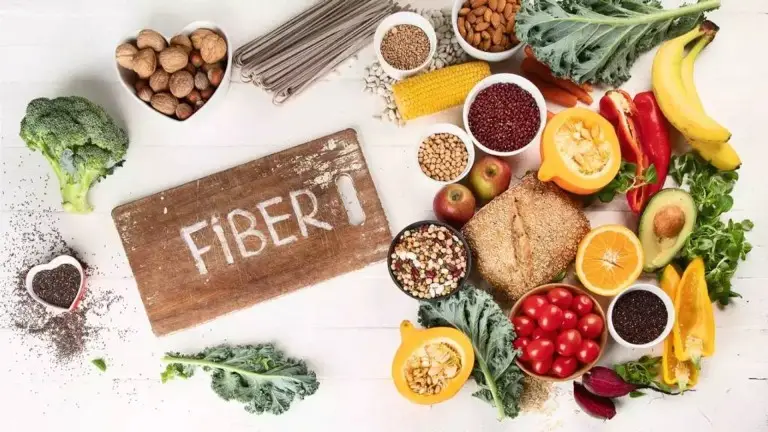
High Fiber Food
- Whole fruits and vegetables, such as berries, apples, broccoli, and spinach
- Whole grains such as quinoa, oats, and brown rice
- Legumes such as lentils, chickpeas, and beans
- Nuts and seeds
How To Increase Fiber Intake
- Start your day with a high-fiber breakfast, such as oatmeal or a fiber-rich smoothie.
- Incorporate fiber-rich foods into your snacks, such as carrot sticks with hummus or a handful of almonds
- Make sure to include a source of fiber with every meal, such as a side salad or a serving of lentils
Remember to vary your fiber sources and try to include a balance of both soluble and insoluble fibers.
5. Use Smaller Plates
Studies suggest that using smaller plates can effectively reduce calorie intake and promote weight loss.
There are a few reasons why smaller plates can lead to smaller portion sizes.
- First, when you use a smaller plate, the food on the plate will appear larger, making you feel like you are eating more.
- Second, when you have less space on your plate, you are less likely to pile on extra food.
Of course, using smaller plates is not a magic bullet for weight loss. Combining this strategy with other healthy lifestyle changes is important, such as eating a healthy diet and exercising regularly.

Tips For Reducing Portion Sizes
- You should use a smaller plate for your main meals.
- Try to eat slowly, savoring each bite and paying attention to your body’s hunger and fullness cues.
- Avoid going back for seconds.
- Divide your plate into smaller portions, half filling it with fruits and vegetables.
Remember, weight loss is not about deprivation, it’s about making healthier choices and finding a balance. Using smaller plates is a simple habit that can help you to eat less without feeling deprived.
6. Exercise Regularly
Exercising regularly is essential for fat loss. Not only does it burn calories, but it also helps to boost metabolism and build muscle mass.
It has been scientifically proven that regular physical activity can improve overall well-being beyond the aesthetic benefits.
The benefits of exercise are vast and profound, from boosting mood and reducing stress to enhancing cognitive function and preventing chronic diseases.

Types Of Exercise For Weight Loss
- Aerobic exercise can include walking, jogging, cycling, swimming, or dancing.
- Strength training exercises such as weightlifting, bodyweight exercises, or resistance bands
- High-intensity interval training (HIIT) combines short bursts of intense activity with periods of rest.(1)
- Yoga or Pilates for flexibility and balance
Tips For Incorporating Exercise Into Your Daily Routine
- Set small, achievable goals and gradually increase the intensity and duration of your workouts.
- Identify an activity that you enjoy and that suits your lifestyle.
- Do exercise a priority and schedule it into your schedule.
- Try to exercise with a friend or a group, it can be more fun and motivating.
- Always warm up and cool down properly before and after exercise.
Remember, consistency is key when it comes to exercise. Aim for at least 30 minutes of moderate-intensity exercise most days of the week.
7. Drink Plenty Of Water
Consuming a sufficient amount of water can aid in weight loss by reducing your dietary intake, particularly when consumed prior to a meal.
Not only does it help to flush out toxins and keep your body hydrated, but it also helps to suppress your appetite. When you feel thirsty, it’s easy to mistake that feeling for hunger, leading you to eat more than you need to.
Make sure to drink water or other drinks with fewer calories instead of soda, which has a lot of sugar and calories and can make you gain weight.
Green tea is full of health benefits and contains antioxidants and healthy compounds. Green tea has no calories, it helps to boost metabolism and improve your body’s efficiency for burning energy.

Tips To Increase Water Intake
- Start your day with a glass of water
- Always keep a water bottle with you and refill it regularly.
- Drink a glass of water before each meal to help control your appetite
- Add a slice of lemon or lime to your water for a refreshing twist
- Use a water tracking app to help you stay on track with your water intake
Remember, it’s important to listen to your body and drink water when you feel thirsty. Aim to drink at least 8–10 glasses of water a day and adjust according to your needs.
Main Sources of Calories
Carbohydrates, proteins, and fat are the three macronutrients that constitute the majority of calories in the diet.
1. Carbohydrates
Carbohydrates are the body’s primary energy source and can be found in foods like grains, fruits, vegetables, and dairy products.
They come in two forms: simple and complex.
- Simple carbohydrates are quickly digested and provide a quick burst of energy.
- Complex carbohydrates take longer to digest and provide a more sustained energy source.
2. Protein
Proteins are essential for building and repairing tissues in the body and are found in foods like meat, fish, poultry, eggs, and beans.
They comprise amino acids, which the body uses to build and maintain muscles, organs, and other tissues.
3. Fat
Fat is also a source of energy and is found in foods like meat, dairy products, nuts, seeds, and oils. There are different types of fat, including saturated, unsaturated, and trans fat.
Unsaturated fats, like those found in olive oil, avocados, and nuts, are considered healthier than saturated and trans fats, which are found in processed foods, fried foods, and baked goods.
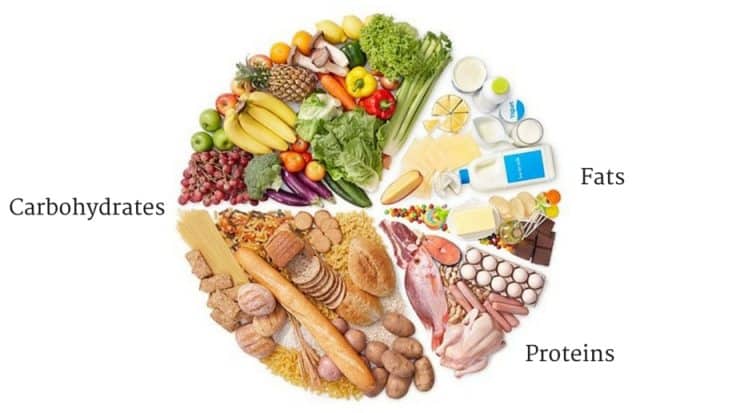
Calories In Common Food Components
| Food Component | Energy per Gram |
|---|---|
| Carbohydrates | 4 calories/gram |
| Protein | 4 calories/gram |
| Fat | 9 calories/gram |
Weight Loss Calculator By Calorie Intake
1. Calories In Fruits
| Fruit | Serving Size | Calories |
|---|---|---|
| Apple | 1 medium | 72 |
| Banana | 1 medium | 105 |
| Orange | 1 medium | 62 |
| Grapefruit | 1/2 medium | 52 |
| Peach | 1 medium | 59 |
| Pear | 1 medium | 101 |
| Pineapple | 1 cup | 82 |
| Watermelon | 1 cup | 46 |
| Strawberries | 1 cup | 49 |
| Blueberries | 1 cup | 84 |
| Raspberries | 1 cup | 64 |
| Blackberries | 1 cup | 62 |
| Mango | 1 medium | 135 |
| Kiwi | 1 medium | 61 |
| Grapes | 1 cup | 104 |
| Papaya | 1 cup | 62 |
| Cherries | 1 cup | 97 |
| Apricot | 1 medium | 17 |
| Cantaloupe | 1 cup | 54 |
| Honeydew | 1 cup | 64 |
| Lemon | 1 medium | 24 |
| Lime | 1 medium | 20 |
| Pomegranate | 1 medium | 234 |
2. Calories In Vegetables
| Vegetable | Serving Size | Calories |
|---|---|---|
| Asparagus | 1 cup | 27 |
| Bell Pepper | 1 medium | 24 |
| Broccoli | 1 cup | 55 |
| Carrots | 1 cup | 52 |
| Cauliflower | 1 cup | 28 |
| Celery | 1 cup | 16 |
| Cucumber | 1 cup | 16 |
| Green Beans | 1 cup | 31 |
| Kale | 1 cup | 33 |
| Lettuce (romaine) | 1 cup | 8 |
| Mushrooms | 1 cup | 15 |
| Onion | 1 cup | 64 |
| Peas | 1 cup | 118 |
| Spinach | 1 cup | 7 |
| Sweet Potato | 1 medium | 103 |
| Tomato | 1 medium | 22 |
| Zucchini | 1 cup | 20 |
3. Calories In Nuts and Oil seeds
| Nuts and Oil seeds | Serving Size | Calories |
|---|---|---|
| Almonds (raw) | 1 oz (23 nuts) | 164 |
| Brazil nuts (raw) | 1 oz (6 nuts) | 185 |
| Cashews (raw) | 1 oz (18 nuts) | 157 |
| Chia seeds | 1 oz (2 tbsp) | 138 |
| Flaxseeds | 1 oz (3 tbsp) | 150 |
| Hazelnuts (raw) | 1 oz (21 nuts) | 176 |
| Hemp seeds | 1 oz (2 tbsp) | 155 |
| Macadamia nuts (raw) | 1 oz (10-12 nuts) | 204 |
| Peanuts (roasted) | 1 oz (28 nuts) | 166 |
| Pecans (raw) | 1 oz (19 halves) | 193 |
| Pine nuts (raw) | 1 oz (167 nuts) | 191 |
| Pistachios (raw) | 1 oz (49 nuts) | 159 |
| Pumpkin seeds (roasted) | 1 oz (85 seeds) | 151 |
| Sesame seeds | 1 oz (3 tbsp) | 160 |
| Sunflower seeds | 1 oz (3 tbsp) | 164 |
| Walnuts (raw) | 1 oz (14 halves) | 185 |
4. Calories In Protein Rich Foods
| Protein Food | Serving size | Calories |
|---|---|---|
| Chicken breast, skinless | 3 oz | 142 |
| Ground beef, 93% lean | 3 oz | 164 |
| Salmon, Atlantic, farmed | 3 oz | 155 |
| Tuna, canned in water | 3 oz | 100 |
| Shrimp, cooked | 3 oz | 84 |
| Turkey breast, skinless | 3 oz | 140 |
| Pork chop, center rib, boneless | 3 oz | 221 |
| Lentils, cooked | 1/2 cup | 115 |
| Chickpeas, cooked | 1/2 cup | 134 |
| Black beans, cooked | 1/2 cup | 114 |
| Tofu, firm, raw | 1/2 cup | 183 |
| Greek yogurt, plain, low-fat | 6 oz | 100 |
| Cottage cheese, low-fat | 1/2 cup | 81 |
| Egg, large, boiled | 1 large | 78 |
| Almonds, dry roasted | 1 oz | 170 |
| Peanut butter, creamy | 2 tbsp | 180 |
| Quinoa, cooked | 1/2 cup | 111 |
5. Calories In Snacks and Common Meal
| Snacks | Serving Size | Calories |
|---|---|---|
| Potato chips, plain, salted | 1 ounce | 155 |
| Bread, white | 1 slice (1 oz.) | 75 |
| Pretzels, hard, plain, salted | 1 ounce | 108 |
| Granola bar, chewy, with raisins | 1.5 oz bar | 193 |
| Graham cracker, plain, honey, or cinnamon | 1 cracker | 59 |
| Chocolate chip cookie (from packaged dough) | 1 cookie | 59 |
| Raisins | 1.5 oz | 130 |
| Hamburger | 1 sandwich | 250 |
| Cheeseburger | 1 sandwich | 285 |
| Corn | 1 cup | 132 |
| Pizza | 1 slice (14”) | 285 |
| Peanut butter, creamy | 2 tbsp | 180 |
6. Calories In Beverages and Dairy
| Beverages and Dairy | Serving Size | Calories |
|---|---|---|
| Almond Milk (unsweetened) | 1 cup | 30 |
| Beer (regular) | 12 oz | 153 |
| Coffee (black) | 8 oz | 2 |
| Cola | 12 oz | 136 |
| Fruit Juice (unsweetened) | 8 oz | 60-100 |
| Greek Yogurt (plain, non-fat) | 6 oz | 100 |
| Hot Chocolate (prepared with water) | 1 cup | 90 |
| Milk (2% fat) | 8 oz | 122 |
| Orange Juice (freshly squeezed) | 8 oz | 112 |
| Protein Shake (whey, vanilla) | 1 scoop (25 g) | 120 |
| Red Wine | 5 oz | 123 |
| Soy Milk (unsweetened) | 1 cup | 80 |
| Sparkling Water | 12 oz | 0 |
| Tea (black, brewed) | 8 oz | 2 |
| Water | 8 oz | 0 |
| White Wine | 5 oz | 121 |
Know Calories Burned During 30 Min Activity To Calculate Weight Loss Calories
Harvard Medical School has compiled a list of calorie burn estimates for various activities lasting 30 minutes, and it’s worth noting that even activities like sitting and watching TV can burn calories in addition to your basal metabolic rate (BMR).
| Activity | 125lb person | 155lb person | 185lb person |
| Walking: 3.5 mph (17 min/mi) | 120 | 149 | 178 |
| Weight Lifting: general | 90 | 112 | 133 |
| Stretching, Yoga | 120 | 149 | 178 |
| Weight Lifting: vigorous | 180 | 223 | 266 |
| Stair Step Machine: general | 180 | 223 | 266 |
| Hiking: cross-country | 180 | 223 | 266 |
| Rowing, Stationary: Moderate | 210 | 260 | 311 |
| Rowing, Stationary: moderate | 210 | 260 | 311 |
| Circuit Training: general | 240 | 298 | 355 |
| Rowing, Stationary: vigorous | 255 | 316 | 377 |
| Boxing: sparring | 270 | 335 | 400 |
| Rope Jumping | 300 | 372 | 444 |
| Swimming: laps, vigorous | 300 | 372 | 444 |
| Bicycling, Stationary: vigorous | 315 | 391 | 466 |
| Running: 7.5 mph (8 min/mile) | 375 | 465 | 555 |
FAQs
What is a weight loss calculator?
A weight loss calculator is a tool that estimates the number of calories a person should consume each day to achieve their desired weight loss goal.
It considers factors such as age, sex, weight, height, and activity level to determine the daily calorie intake required to lose weight.
How accurate are weight loss calculators?
Most weight loss calculators are accurate, but they should not be used as the only source of information for a weight loss plan. Their estimates are based on averages and do not consider individual metabolism and body composition differences.
How many calories should I eat to lose weight?
The number of calories you need to eat to lose weight depends on several factors, including your age, sex, height, weight, and activity level.
Generally, women should consume between 1,200 and 1,500 calories daily, while men should consume between 1,500 and 1,800 calories daily.
Talking to a healthcare professional or registered dietitian is important to determine your calorie range.
Can I lose weight by simply cutting calories?
Yes, reducing the number of calories you consume can help you lose weight. It’s important to ensure you get all the nutrients your body needs.
A balanced diet that includes fruits, vegetables, whole grains, lean protein, and healthy fats is essential for achieving long-term weight loss success.
How do I know how many calories I’m eating?
The use of a food diary or food tracking app can help you track your daily calorie intake.
Many fitness and nutrition apps allow you to enter your meals and snacks into the app and calculate the total number of calories you eat.
Is it safe to drastically reduce my calorie intake to lose weight quickly?
It is not recommended to lose weight quickly because it can be harmful to your health. Drastically reducing your calorie intake can lead to nutrient deficiencies, muscle loss, and other health problems.
Aiming for a gradual weight loss of 1–2 pounds per week is important.
Should I exercise to lose weight?
Yes, exercise is an important component of weight loss. Not only does it burn calories, but it also helps to build muscle and boost your metabolism.
Aim to get at least 30 minutes of moderate-intensity exercise most days of the week for optimal weight loss results.
How long will it take to lose weight?
It takes a long time to lose weight, depending on how much weight you need to lose, how many calories you eat, and how much exercise you get.
A healthy rate of weight loss is 1–2 pounds per week. It is possible to achieve significant weight loss over the course of several months with consistent effort.
Takeaways
Weight loss and calorie intake are closely related, and determining the right number of calories is key to achieving healthy weight loss. A weight loss calculator can be useful for determining the right number of calories for your weight loss goals.
However, it is important to remember that sustainable weight loss is not just about cutting calories but also about incorporating healthy lifestyle changes such as regular exercise, balanced nutrition, and stress management.
References:
- Johnstone AM, Murison SD, Duncan JS, Rance KA, Speakman JR, Factors influencing variation in basal metabolic rate include fat-free mass, fat mass, age, and circulating thyroxine but not sex, circulating leptin, or triiodothyronine1. Am J Clin Nutr 2005; 82: 941-948.
- Schwarz, N. A., Rigby, B. R., La Bounty, P., Shelmadine, B., & Bowden, R. G. (2011). A Review of Weight Control Strategies and Their Effects on the Regulation of Hormonal Balance. Journal of Nutrition and Metabolism, 2011.
- Rossow, L. M., Fukuda, D. H., Fahs, C. A., Loenneke, J. P., & Stout, J. R. (2013). This Link Will Open A PDF DocumentNatural bodybuilding competition preparation and recovery: a 12-month case study. International Journal of Sports Physiology and Performance, 8(5), 582–592.
- Muller, M. J., Enderle, J., Pourhassan, M., Braun, W., Eggeling, B., Lagerpusch, M., … Bosy-Westphal, A. (2015). Metabolic adaptation to caloric restriction and subsequent refeeding: the Minnesota Starvation Experiment revisited. The American Journal of Clinical Nutrition, 102(4), 807–819.
- Davoodi SH, Ajami M, Ayatollahi SA, Dowlatshahi K, Javedan G, Pazoki-Toroudi HR. Calorie shifting diet versus calorie restriction diet: a comparative clinical trial study. Int J Prev Med. 2014;5(4):447–456.
- Burke L. E., Wang J., Sevick M. A. (2011). Self-monitoring in weight loss: A systematic review of the literature. Journal of the American Dietetic Association, 111, 92–102.

Manish brings over 10 years of hands-on experience in weight lifting and fat loss to fitness coaching. He specializes in gym-based training and has a lot of knowledge about exercise, lifting technique, biomechanics, and more.
Through “Fit Life Regime,” he generously shares the insights he’s gained over a decade in the field. His goal is to equip others with the knowledge to start their own fitness journey.
